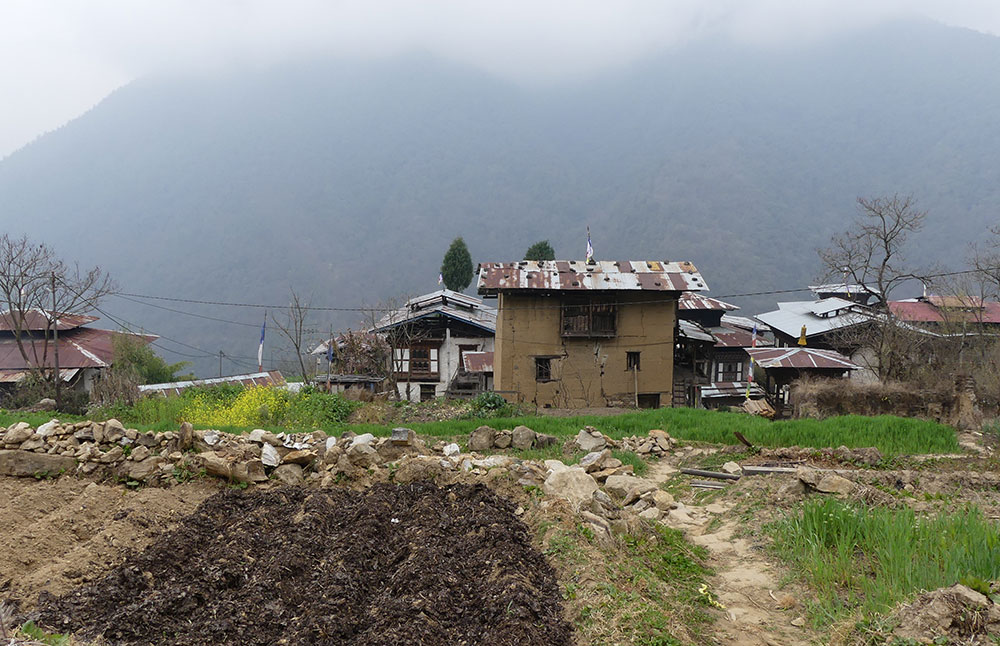Dechen Dolkar
Step into the Jongthang village, tucked away in the remote corners of Nubi Gewog in Trongsa.
Here, amidst rustic charm, you’ll find the only homestay welcoming travellers from afar.
Located just a scenic two-hour drive from Trongsa Dzong, this hidden gem offers a unique opportunity to immerse yourself in the authentic culture and tranquillity of rural Bhutan.
At the parking lot, the Sangay Dorji’s family greets guests warmly with “Kuzu Zangpo La!” and asks how their journey was.
Sangay Dorji, a 70-year-old from Jongthang village, has opened his doors to travellers this year. He sees the potential to welcome both local and international tourists.
His one-storey farmhouse, built three years ago at a cost of Nu 4.5 million, provides a haven for both tourists and local officials.
At his homestay, you’ll enjoy “farm-to-table” cuisine, where Sangay sources vegetables and grains locally from the village farm.
He prepares Bhutanese dishes like puta, jangbali, and khuley, all abundant in the region. The villagers also cultivate all the dru na gu.
Sangay’s homestay stands out in the village with eight well-equipped rooms and modern amenities, including toilets—a luxury not commonly found in the traditional three-storey mud-built homes of Jongthang.
The homestay is the only one in the village equipped with modern toilets, making it especially appealing to tourists who seek both comfort and cultural immersion.
Sangay Dorji has not yet applied for certification for his homestay. He said that so far, only local officials have stayed at his farmhouse, and he has not received any bookings from tourists.
Sangay Dorji said that with the increasing number of tourists visiting the village each year, he felt the need to create a welcoming space where visitors could experience the local culture and traditions.
Every year, three to four groups of tourists visit the village to experience its culture and go trekking.
The tourists stay overnight in the village, setting up tents. When tourists arrive in Jongthang, they are warmly welcomed by the local communities, offering genuine hospitality.
“The local communities offer them Ara—a local drink—and entertain the guests with traditional songs and dances,” Sangay said. “They even get to witness the making of Ara and simple local delicacies, fostering meaningful connections with the villagers.”
Last year, tourists who visited the village put on the table what is needed, and they donated a 5-litre rice cookers, a curry cookers, and radios to each household.
Jongthang has 32 households.
Sangay’s homestay offers affordable rates ranging from Nu 500 to Nu 1,600 per night, excluding food, making cultural immersion accessible to all travellers.
The Nubi Gup, Pema Lhamo, said that Jongthang stands out as a tourist destination due to its unique culture and traditions, providing visitors with a one-of-a-kind experience.
“Many tourists visit the village to experience rich culture of rural Bhutan which benefits both local and the lone farm house,” Pema said. “ Tourism is promising in Jongthang with the construction of ecotrail along the way to Dur tshachhu.”
However, she said that challenges remain—two bridges needs to be constructed along this eco-trail. Currently, suspension bridge over Mangduechhu is under construction.
The gewog needs additional funding to construct essential bridges like the bazam at Sharcho—two bridges would be nedded to connect Jongthang with Dur tshachhu.
“This initiative holds the potential to transform Jongthang into a bustling tourism hotspot,” Pema Lhamo said.
The ecotrail receives funding from several organisations, including the Tourism Council of Bhutan, Vanishing Treasure, Bhutan for Life, and the gewog grant.
The ecotrail will benefit both tourists and Bhutanese people who wish to go to Dur Tshachhu. It also shortens the distance for travellers.
This news story is from the field notes of our reporter who observed the villages facing human-wildlife conflicts in Trongsa with UNEP’s Vanish- ing Treasures Programme


